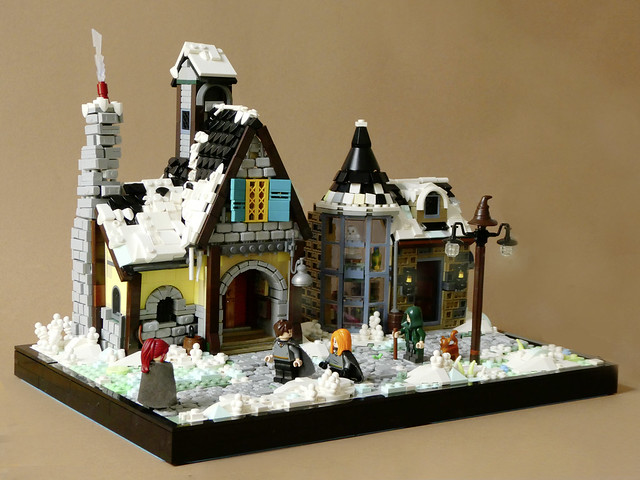While I have no discernable ability to build a Bionicle creation myself (though I always dream of one day building one), I’m a great admirer of the amazing creations Bionicle builders come up with. There is just so much more that’s possible than with bricks and plates alone. Take Moko’s Cancer for example. While it would be terrifying to encounter such a thing in reality, as a LEGO creation it’s really quite beautiful. The texture is what I’m really drawn to. Bionicle offers pieces in so many shapes, curved and flowing together that when paired together they give the appearance of a figure missing its skin, like Lord Zedd from the Power Rangers or perhaps something more alien, such as Marvel Comics’ Carnage.
Posts by David Guedes
Sometimes the parts used are as beautiful as the whole
I’m a sucker for new or nice parts usage (NPU) and Simon NH knows the way to my heart. So allow me to fangirl out at for a moment at his latest Harry Potter creation, Winter in Hogsmeade.
Did you see the brick walls built out of Mjölnirs or the underside of jumpers? Or the window arch made out of cheese held in by pressure alone? I love the modified plates with teeth as shingles and the lance as a downspout. How about the welding torch as a sconce, or the (extremely in-theme) sorting hat as the top of the lamppost. I’m really only scratching the surface here, as there are all kinds of other creative parts usages throughout, and that’s not even mentioning the smart colour choices (like, hello yellowish-green and light aqua as frozen grass). The creation as a whole is fantastic, but the smart use of parts really does make a LEGO fan weak in the knees.
A kinetic sculpture fit for a god [Video]
In Greek mythology, Apollo is a somewhat complicated figure, so it seems only fitting that he’s the subject matter of Jason Allemann’s latest kinetic sculpture. Building upon his previous galloping horse, he’s expanded the moving parts in this creation to include the horse’s legs, bodies, necks, heads and tails, as well as the chariot body and wheels and Apollo himself. He’s done such a good job making the overall movement look natural, it can be hard to pick out what parts are actually moving independently of each other. It all just flows together quite well.
Like everything Jason designs, the mechanics behind it all are quite clever, but even without the movement, this would still be a well-designed static model. I really like the way he’s sculpted the head and face, using a simply gap between pieces to represent the eyes and brow. Also pleasing are the choices of gold elements to adorn the chariot, giving it that ancient and regal look. The relatively new 22 long hose with connector ends is an especially smart choice for the reins. Watch the video he made and take a moment to be mesmerized by the model’s motion and hear about all about the mechanics from Jason himself.
Landscape and trees tell a story
While not depicting any particular scene I can remember, Mountain Hobbit’s Fishing Docks is clearly set in Middle Earth. The colour palette is consistent with the official sets, and Gollum lurking behind one of the trees on the hill is a dead giveaway. Let’s talk about those trees and hill though. The shaping of both is superb. Everything is basically sculpted using slopes and wedges. I really like the heavy use of pieces that are one brick wide on the hillside, giving it the appearance of being quite weathered. The curve on the rightmost tree is particularly well done, as it tells a story about how that tree grew: when it started growing, it wasn’t so close to the edge, but over time, its trunk grew thicker and the hillside eroded. Because of geotropism, the tree grew to point upward though, giving it the curved trunk we see today.
Darkness rises and light to meet it
We’re currently a month and half away from the final installment in the Skywalker saga, (not that anyone at The Brothers Brick is counting). At this point, everything we know about it is from the toys, trailers and promotional images, but that can’t stop eager LEGO builders from making creations based on the movie. Following some brilliant recreations of scenes in other recent Star Wars movies, KevFett2011 has recreated what I’m sure will be a memorable and iconic scene from the next film. Potential spoilers ahead if you’re avoiding the trailers and/or our speculation turns out to be correct.
Mech made of minifigures
Minifgure accessories are an often underused section of the LEGO parts palette. While many builders may think up creative ways to integrate these parts outside of the use they were designed for, many of us lack the quantity needed to carry out our ideas. Markus Rollbühler manages to pull it off with ease though with his latest mech Black Widow.
Obvious standouts are Count Dooku’s lightsabers and the skeleton pattern armour, and both elements help give the legs an organic shape, while the armour’s print is perfect for an arachnoid style mech. I’m personally quite excited to see the relatively new neck bracket with 4 handles used to help shape the body of the mech. When that piece was revealed, I expected to see it in more creations and I’m hoping this is the start of a trend. Non-minfigure parts are expertly used here as well, such as the main section being flawlessly shaped with a Zamor Sphere holder forming a natural spine. Finally, my favourite bit of texture is created using a Technic connector on the legs – not only is the piece functional, but it looks good too!
Fastest hunk of junk in the galaxy in 1/72 scale
The Millennium Falcon is one of the most iconic ships in Star Wars, and perhaps all science fiction. It’s so familiar that it’s been made into quite a few official LEGO sets as well as countless fan creations. Interestingly, despite the numerous recreations, there’s still room for new design ideas, such as Tim Goddard’s latest 1/72 scale version.
Built at this scale to fit in with some of his other Star Wars ships, this model is full of interesting design features. A very noticeable aspect of the build is the sheer variety of pieces used. This is evident in the shaping of the overall shape of the ship, as well as in the details, like the cockpit. And that’s not even mentioning the greebles that emphasize the pieced togetherness of the fastest hunk-a-junk in the galaxy. The smartest design choice though, has to be the colours. Not content with the same old mixture of gray with splashed of dark red and various earth tones, this version of the Falcon features a mix of old and new light gray, further hammering home the point that the ship really is scrapped together.
Unique take on a classic TIE Fighter
Despite its relatively simple design, it’s amazing how many different approaches there have been to building LEGO TIE Fighters, in both official sets and fan creations. The latest design to catch our eye, is Fuku Saku’s rendition.
It’s interesting to see what features tend to be common among the various versions, such as the seemingly natural use of round corner dome top bricks to shape the cockpit. More interesting though, is what’s unique. While wings in LEGO TIE Fighters have often been made of brick, plate, or tile, this model takes them a step further and uses grille tiles to give the wings a more accurate solar panel texture. Another feature that’s often different, and is again here, is the design of the forward facing lasers. They’ve been represented by so many different parts in the past, and here they’re masterfully recreated using one of my favourite subtle decortative elements, the Technic 3/4 pin.
Small gatehouse is big display of medieval architecture
LEGO castles offer builders countless opportunities to use pieces in innovative ways, but executing that variety effectively often requires quite a large castle. Atahlus’ latest creation demonstrates how you can include a variety of different techniques in a relatively small model, while still giving off the air of a large and imposing castle.
While a singular building, this gatehouse demonstrates three separate types of structures. On the right you have the red, half-timber style structure that would be just as much at home in a medieval village as it would be built onto the side of a castle. Opposite it on the left is a round tower with its tall, buttressed walls, implying a stronger, more fortified look. Contrast both sides to the delicate look of the center section, reminiscent of a gothic cathedral. Here in the center, the parts usage is particularly intriguing, with seamless integration of modified bricks, bars, and robot claws to achieve a fragile character. Grey microfigures are also used effectively here as sculpted window frames, as well as on the crenellations on the left section.
Commemorating the Peterloo Massacre
August of this year marked the 200th anniversary of the Peterloo Massacre. To commemorate the massacre, James Pegrum, Dan Harris and Simon Pickard collaborated to build a LEGO diorama of the event. In their research on the subject, the team consulted an expert historian and the creators of a graphic novel depicting the Peterloo Massacre. They tried to recreate everything as accurately as possible.
See more of this action-packed display.
Build castle classic again
Many older fans of LEGO might long for the days of yore, before we had fancy things like minifigures and molded animals. Grantmasters liked those good old days when we had to build our own horses. After all, the first LEGO horse wasn’t introduced until 1984, years after the first castle sets with brick-built horses. With his latest creation, Grant took it a step further and built his own people too!
The use of some pretty basic elements give his Crusaders a sturdily armoured look. And though he’s rejected newfangled molds for people and animals, he’s adeptly sculpted a horse with the use of new elements, such as the curved slopes, quarter round tiles, and my current favouite use of the power blast piece, giving the horse’s head just the right shape.
Introducing the Like Launcher [Video]
Over the years, we here at The Brothers Brick have written a few guides about how to get your LEGO creations featured on our website. But what if you want more? Well then janbenedict_yap has the solution for you! Introducing the Like Launcher!
Use it launch some Facebook likes into the world and maybe some of those good vibes will come back to you in the form of likes on pictures of your LEGO models. Simply load a like into the launcher to fire it at what pleases you. You can utilize it in one of two ways: Trajectory Mode or Direct Fire mode. I know when I like something, my favourite way to let you know is to shoot a thumbs up, right in your face. And now you can too! But don’t take my word for it, check out on video.












